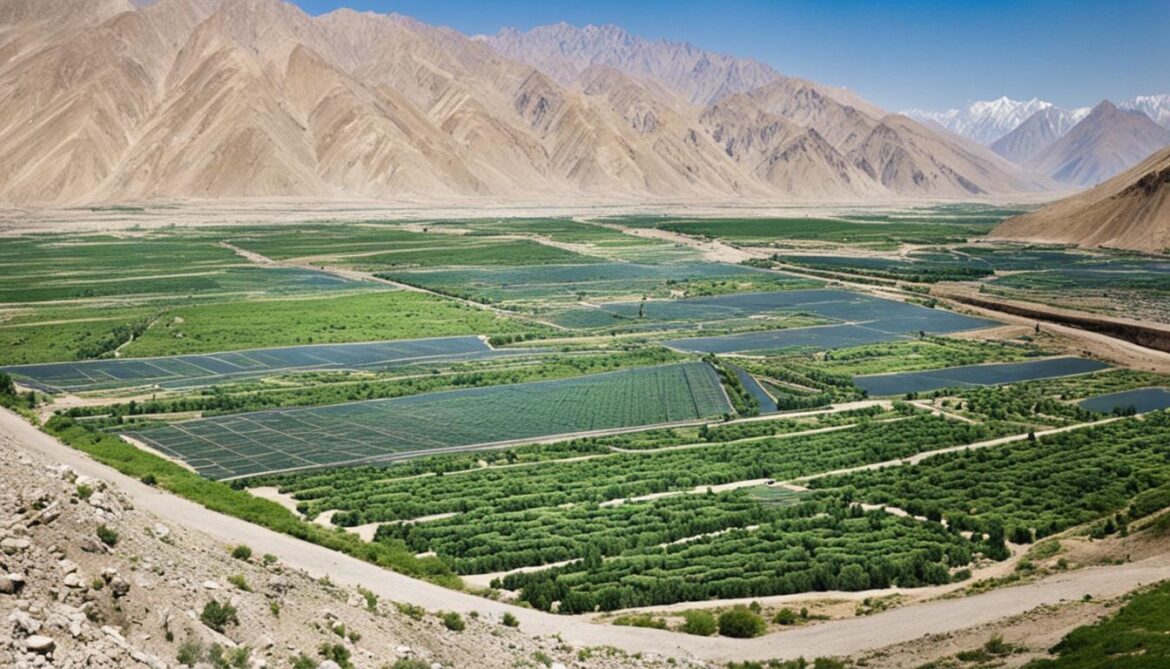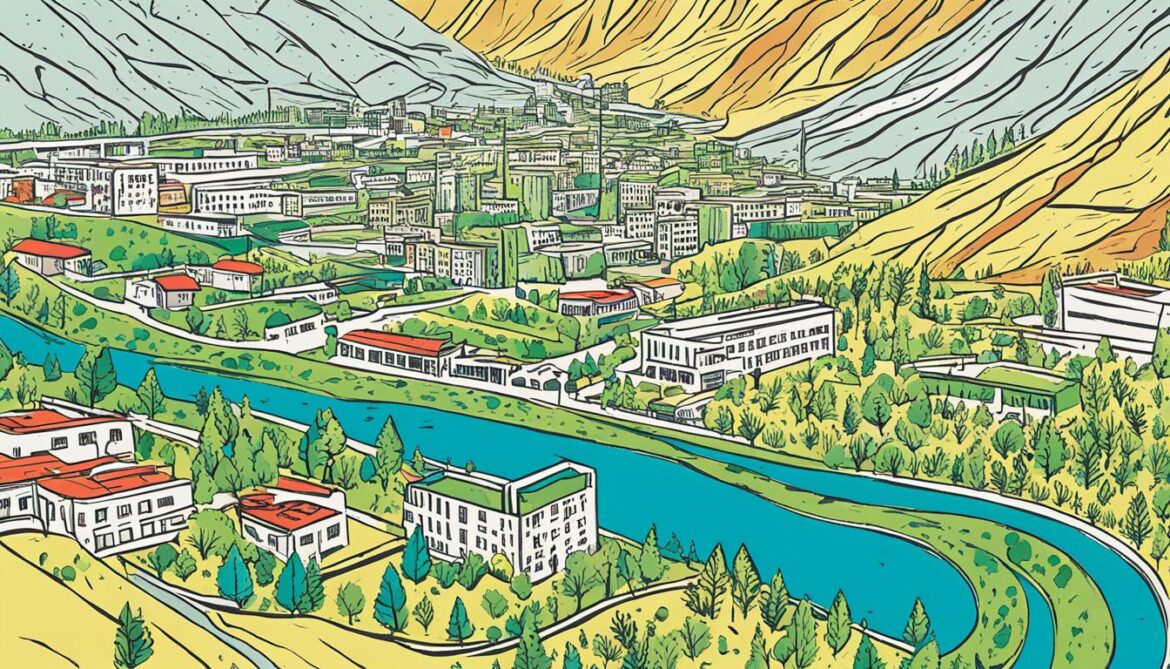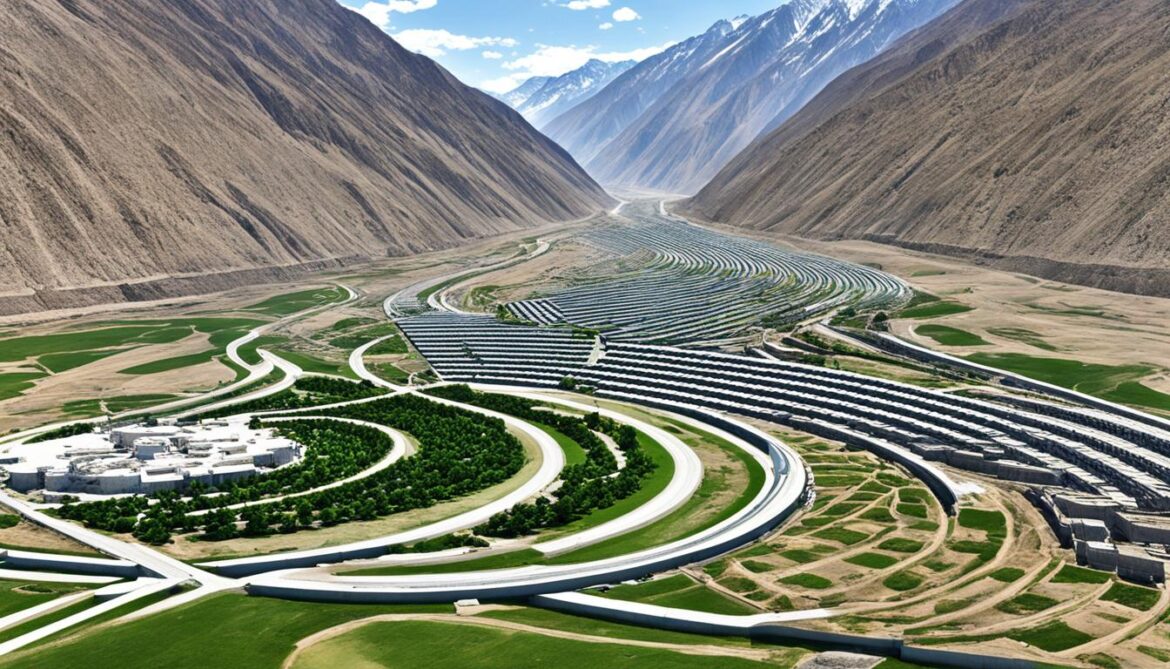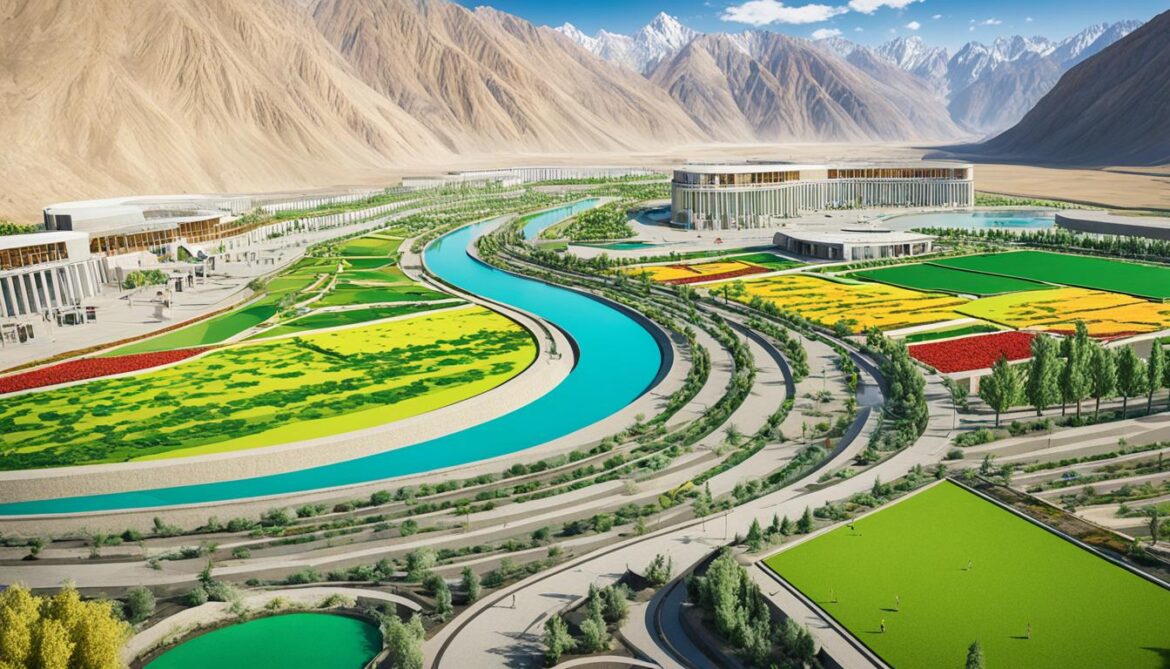Tajikistan is renowned for its impressive biodiversity, boasting over 23,300 species of flora and fauna. The country takes pride in its comprehensive National Strategy and Action Plan on the Conservation and Sustainable Use of Biodiversity, which places a strong emphasis on evaluating and conserving biological resources, genetic pool conservation, and sustainable use of biological resources. However, Tajikistan faces its fair share of challenges, such as climate change and habitat destruction, which highlights the urgent need for continued efforts to preserve its remarkable biodiversity.
Key Takeaways:
- Tajikistan boasts a rich biodiversity, with over 23,300 species of flora and fauna.
- The country’s National Strategy and Action Plan on the Conservation and Sustainable Use of Biodiversity focuses on evaluating and conserving biological resources.
- Tajikistan faces challenges such as climate change and habitat destruction, which underscore the importance of preserving biodiversity.
- Efforts are being made to create a national ecological network and protect critical habitats.
- The National Center for Biodiversity and Biosafety coordinates conservation efforts and collaborates with stakeholders to secure funding for conservation projects.
Implementing the NBSAP
Tajikistan’s National Strategy and Action Plan on the Conservation and Sustainable Use of Biodiversity (NBSAP) was adopted in 2003. The NBSAP focuses on evaluating and conserving biological resources, genetic pool conservation, biodiversity conservation, biological safety, and the sustainable use of resources.
Implementation of the NBSAP includes the creation of a national ecological network to protect diverse ecosystems, targeted conservation efforts for critical habitats, and alignment with global conservation priorities through the Aichi Biodiversity Targets.
The NBSAP aims to strengthen the conservation and sustainable use of Tajikistan’s biological resources through comprehensive measures such as:
- Evaluating the current state of biological resources and identifying areas for improvement
- Implementing conservation strategies to preserve the genetic pool and safeguard biodiversity
- Promoting biological safety through effective monitoring and control measures
- Advancing sustainable resource management practices to ensure the responsible use of biological resources
By focusing on these key objectives, the NBSAP seeks to strike a balance between the conservation of Tajikistan’s rich biodiversity and the sustainable utilization of its natural resources.
“The National Strategy and Action Plan on the Conservation and Sustainable Use of Biodiversity provides a framework for Tajikistan to protect its unique biological heritage while promoting sustainable development.” – Dr. Alisher Rustamov, Director of the National Center for Biodiversity and Biosafety
NBSAP Implementation: Key Initiatives
The implementation of the NBSAP in Tajikistan involves various initiatives aimed at achieving the conservation and sustainable use of biological resources:
| Initiative |
Description |
| National Ecological Network |
The creation of a network of protected areas and ecological corridors to enhance the connectivity and protection of diverse ecosystems across the country. This initiative ensures the long-term conservation of critical habitats and promotes biodiversity conservation. |
| Species Conservation Programs |
Tajikistan has implemented targeted conservation programs for endangered and threatened species, focusing on their protection, habitat restoration, and population recovery. These programs aim to prevent the extinction of vulnerable species and maintain healthy ecological balances. |
| Aichi Biodiversity Targets |
Tajikistan aligns its conservation efforts with the global Aichi Biodiversity Targets, which provide a unified framework for global conservation action. By setting measurable targets, Tajikistan contributes to the international conservation agenda and monitors its progress in achieving these targets. |
Through these initiatives and ongoing collaboration with national and international stakeholders, Tajikistan is proactively working towards the implementation of the NBSAP and the conservation of its rich biodiversity.
Image Caption: The NBSAP guides Tajikistan’s efforts towards the conservation and sustainable use of its biodiversity.
National Center for Biodiversity and Biosafety (NBBC)
The National Center for Biodiversity and Biosafety (NBBC) is the primary coordinating body for biodiversity conservation in Tajikistan. As part of its mandate, the NBBC plays a central role in implementing the National Strategy and Action Plan on the Conservation and Sustainable Use of Biodiversity (NBSAP).
An important aspect of the NBBC’s work is the creation of a comprehensive data bank on the country’s flora and fauna. This data bank serves as a valuable resource for researchers, conservationists, and policymakers, providing essential information to guide biodiversity conservation efforts.
The NBBC recognizes the critical importance of establishing partnerships with stakeholders to maximize the impact of its conservation initiatives. The center collaborates closely with governmental institutions, local authorities, scientific organizations, and non-governmental organizations (NGOs) to foster cooperation and knowledge exchange.
Facilitating Biodiversity Conservation Coordination
“By working together with our partners, we can achieve far more in the realm of biodiversity conservation than we could individually. Through coordination and collaboration, we can address the complex challenges that threaten Tajikistan’s unique flora and fauna.”
The NBBC acts as a catalyst for coordinating efforts among different stakeholders involved in biodiversity conservation. This coordination is crucial to ensure harmonization of conservation initiatives, avoid duplication of efforts, and enable efficient resource allocation.
By fostering strong partnerships, the NBBC strengthens the collective capacity to address biodiversity loss, habitat degradation, and other conservation challenges. Together, these collaborative efforts contribute to the overall protection and sustainable use of Tajikistan’s rich biodiversity.
Supporting Funding and Donor Engagement
“Securing adequate funding and engaging donors are vital for the long-term success of biodiversity conservation. We actively seek partnerships with donors and international organizations to support our conservation projects and initiatives.”
The NBBC actively seeks partnerships with donors and international organizations to secure funding for conservation projects in Tajikistan. By engaging with external stakeholders, the NBBC aims to attract resources that can facilitate the implementation of biodiversity conservation programs at the national level.
These partnerships not only contribute to the financial sustainability of conservation initiatives but also provide opportunities for knowledge exchange, technical expertise, and capacity building. Through collaborative funding efforts, the NBBC strengthens its ability to implement effective conservation strategies that safeguard Tajikistan’s precious biodiversity.
Ensuring a Sustainable Future for Tajikistan’s Biodiversity
“Our vision is to create a future where the conservation of biodiversity is deeply ingrained in all aspects of Tajikistan’s development. By working together, we can build a sustainable future that balances the needs of nature and society.”
The NBBC’s commitment to biodiversity conservation and its partnerships with stakeholders are integral to achieving a sustainable future for Tajikistan. By coordinating efforts, establishing a comprehensive data bank, and seeking funding and donor engagement, the NBBC fosters a coordinated approach to conservation and ensures the long-term preservation of Tajikistan’s unique flora and fauna.
Through its tireless efforts, the NBBC is actively shaping the conservation landscape in Tajikistan, securing a future where biodiversity thrives and natural ecosystems are preserved for generations to come.

Conservation Projects Supported by the NBBC
The National Center for Biodiversity and Biosafety (NBBC) plays a vital role in supporting and coordinating diverse conservation projects in Tajikistan. These projects, in collaboration with partner organizations such as the Ramsar Convention Secretariat, IUCN, World Wildlife Fund, and Snow Leopard Foundation, contribute to the preservation of Tajikistan’s rich biodiversity.
Restoration of Wetland Ecosystems
The NBBC actively supports the restoration of wetland ecosystems in Tajikistan. Wetlands play a crucial role in regulating water resources, providing habitats for various species, and mitigating climate change impacts. Through targeted conservation efforts, the NBBC aims to enhance the health and biodiversity of wetland ecosystems, promoting their sustainable management and protecting them from degradation.
Protection of Endangered Species
Endangered species face numerous threats in Tajikistan due to habitat loss, poaching, and climate change. The NBBC initiates and supports projects focused on protecting these vulnerable species. By implementing conservation measures and engaging local communities, the NBBC aims to safeguard endangered species and ensure their long-term survival.
Sustainable Forest Management
The NBBC recognizes the importance of sustainable forest management in preserving biodiversity and supporting local communities. Through collaboration with forestry organizations and local stakeholders, the NBBC promotes sustainable practices such as reforestation, responsible logging, and protection of forest habitats. These initiatives contribute to the conservation of biodiversity and the sustainable use of forest resources.
Community-Based Conservation Initiatives
Engaging local communities is essential for effective biodiversity conservation in Tajikistan. The NBBC supports community-based conservation initiatives that empower local stakeholders to actively participate in conservation efforts. By involving communities in decision-making processes and establishing sustainable livelihood opportunities, the NBBC ensures the long-term success of conservation projects and fosters a sense of ownership and responsibility among the local population.
“Conservation projects supported by the NBBC contribute significantly to the preservation of Tajikistan’s extraordinary biodiversity and the sustainable development of the country. Through partnerships, proactive measures, and community involvement, these projects are making a tangible difference in protecting wetland ecosystems, endangered species, and forests. The NBBC’s commitment to conservation is vital for securing Tajikistan’s natural heritage for future generations.”
Overall, the NBBC’s support for a wide range of conservation projects reinforces Tajikistan’s commitment to biodiversity conservation and sustainable development. These initiatives demonstrate the country’s dedication to protecting wetland ecosystems, endangered species, practicing sustainable forest management, and fostering community participation in conservation efforts.

Status of Biodiversity
Tajikistan’s biodiversity status showcases the country’s rich variety of ecosystems and species. Spanning different ecoregions, Tajikistan exhibits a high level of species diversity, including numerous endemic species that are unique to its borders. This remarkable biodiversity is a testament to the country’s natural heritage and ecological significance.
However, Tajikistan faces challenges in the realm of agrobiodiversity. Climate change poses a significant threat to agrobiodiversity, leading to the decline of certain crop varieties and agricultural practices. Preserving and protecting agrobiodiversity is crucial for ensuring sustainable agriculture and fostering economic sustainability in Tajikistan.

Biodiversity Status in Tajikistan
Tajikistan’s biodiversity can be attributed to its diverse range of ecoregions, which are distinct ecological zones characterized by unique sets of environmental conditions and species composition. This biodiversity is not just limited to flora and fauna but extends to terrestrial, freshwater, and marine ecosystems.
The country harbors various ecoregions, including the Pamir Mountains, the Foothills and Tien Shan, the Central Asian Deserts and Semi-Deserts, and the Turan Plains. Each ecoregion supports a wide range of habitats and species, contributing to the overall biodiversity of Tajikistan.
Species Diversity and Endemic Species
Tajikistan’s biodiversity is further enhanced by its high species diversity. The country is home to numerous plant and animal species, including many unique and endemic species that are found only within Tajikistan’s borders.
Endemic species are particularly significant as they serve as indicators of biological distinctiveness and environmental health. Their presence highlights the importance of conserving and protecting the natural habitats and ecosystems that sustain their existence.
The Importance of Agrobiodiversity
Agrobiodiversity plays a crucial role in Tajikistan’s agricultural sector and overall food security. It encompasses the wide variety of crops, livestock, and other agricultural resources that contribute to agricultural production and resilience.
Preserving and promoting agrobiodiversity is essential for sustainable agriculture, as it increases the adaptive capacity of farming systems and enhances their resilience to climatic changes and pests. It also provides opportunities for the development of diverse and nutritious food systems.
However, climate change poses a significant threat to agrobiodiversity in Tajikistan. Rising temperatures, changing rainfall patterns, and extreme weather events can impact crop productivity, disrupt pollination processes, and increase the vulnerability of agricultural systems.
Efforts to safeguard agrobiodiversity in Tajikistan involve the conservation of traditional crop varieties, the promotion of sustainable farming practices, and the development of climate-resilient agriculture. These measures aim to ensure the long-term sustainability of agriculture and food security in the face of climate change.
Biodiversity Status Table
| Ecoregion |
Species Diversity |
Endemic Species |
| Pamir Mountains |
High |
Yes |
| Foothills and Tien Shan |
Moderate |
Yes |
| Central Asian Deserts and Semi-Deserts |
High |
No |
| Turan Plains |
High |
No |
The Impact of Climate Change on Tajikistan’s Economy
Tajikistan has experienced the undeniable impacts of climate change, with one of the most significant being the loss of glacier cover. Glacier cover loss has dire consequences for the country’s freshwater resources, contributing to water scarcity and affecting key sectors like agriculture and hydropower generation. The agricultural sector, which plays a vital role in Tajikistan’s economy, is particularly vulnerable to the effects of climate change.
The rising temperatures and changing precipitation patterns associated with climate change pose significant challenges to the agricultural sector. Changes in temperature and rainfall patterns can disrupt crop growth and reduce agricultural productivity, leading to food insecurity and economic instability. These adverse effects have a direct impact on the livelihoods of farmers and the overall agricultural output in the country, affecting food availability and exacerbating poverty.
Furthermore, climate change increases the risk of natural disasters in Tajikistan, such as floods and landslides. These disasters not only result in the loss of human lives and damage to infrastructure but also cause severe economic disruptions. The destruction of vital infrastructure, including roads, bridges, and irrigation systems, hampers economic development and recovery.
“The impact of climate change on Tajikistan’s economy cannot be underestimated. It poses a significant threat to key sectors, such as agriculture, and increases the vulnerability of the population to natural disasters.” – Dr. Alisher Faizullaev, Climate Change Expert
Climate change requires urgent attention and mitigation efforts to minimize its devastating impact on Tajikistan’s economy. Implementing climate resilience measures, such as developing drought-tolerant crops, promoting sustainable irrigation practices, and investing in climate-smart agricultural techniques, can help mitigate the vulnerability of the agricultural sector.
In addition, enhancing disaster preparedness and response mechanisms, improving early warning systems, and implementing infrastructure resilience measures can help reduce the economic and social impact of natural disasters. Collaborative efforts between the government, international organizations, and local communities are crucial in fostering climate change resilience and minimizing the adverse effects on Tajikistan’s economy.
Economic Impacts of Climate Change on Tajikistan
| Economic Sectors |
Key Impacts |
| Agriculture |
Reduced crop productivity, food insecurity, increased poverty |
| Hydropower Generation |
Decline in water availability leads to decreased energy production |
| Infrastructure |
Damage to roads, bridges, and irrigation systems affects economic development |
| Tourism |
Loss of glacier cover affects the attractiveness of tourist destinations |
Challenges in the Regulatory Environment for Investment in Tajikistan
Tajikistan’s regulatory environment for investment presents several challenges that hinder economic growth and development. These challenges encompass poor implementation of regulations, lack of transparency, corruption issues, and limited participation from the domestic private sector. Such difficulties contribute to the country’s low ranking in the Ease of Doing Business index, making it less attractive to potential investors.
The poor implementation of regulations creates uncertainty and inconsistency, creating obstacles for businesses seeking to operate in Tajikistan. This inconsistency breeds a lack of transparency, making it difficult for investors to navigate the regulatory landscape and understand their rights and obligations. Moreover, corruption issues further complicate the investment process, deterring potential investors who fear the risk of corrupt practices and unethical conduct.
Furthermore, limited participation from the domestic private sector exacerbates the challenges faced by Tajikistan’s regulatory environment. The lack of involvement from local businesses restricts economic growth and limits the opportunities for sustainable investment.
To address these regulatory environment challenges, Tajikistan must prioritize enhancing transparency and strengthening the rule of law. Implementing measures to combat corruption and promote ethical practices will contribute to a more favorable investment climate. Additionally, actively involving the domestic private sector is crucial for attracting sustainable investment and fostering economic growth.
Key Challenges in Tajikistan’s Regulatory Environment for Investment:
- Poor implementation of regulations
- Lack of transparency
- Corruption issues
- Limited participation from the domestic private sector
By addressing these challenges head-on, Tajikistan can create a more conducive regulatory environment that encourages investment, stimulates economic growth, and fosters a prosperous future for the country and its people.
| Challenge |
Description |
| Poor implementation of regulations |
Inconsistent application of regulations creates uncertainty for businesses. |
| Lack of transparency |
Absence of clear and accessible information regarding regulations and investment procedures. |
| Corruption issues |
Pervasive corruption undermines the integrity of the investment process. |
| Limited participation from the domestic private sector |
Insufficient involvement of local businesses restricts economic growth and investment opportunities. |

In conclusion, addressing the challenges in Tajikistan’s regulatory environment for investment is essential for creating a more attractive investment climate. Enhancing transparency, strengthening the rule of law, combating corruption, and actively involving the domestic private sector will contribute to attracting sustainable investment and fostering economic growth in Tajikistan.
Challenges in Tajikistan’s Infrastructure
Tajikistan’s infrastructure presents significant challenges to its economic growth and development. The poor state of infrastructure in the country has far-reaching consequences, including high trade costs and limited access to markets. The energy infrastructure also faces numerous obstacles, leading to inefficient energy distribution and transmission, frequent power outages, and reliability issues.
To tackle these challenges, Tajikistan is making strategic investments in the development of renewable energy sources and the improvement of transportation networks. By diversifying its energy mix and promoting the use of renewable resources, Tajikistan aims to enhance energy efficiency, reduce dependency on fossil fuels, and ensure a more reliable power supply for its citizens.
“Investing in renewable energy not only addresses the challenges of energy infrastructure but also promotes sustainability and environmental stewardship,” says Dr. Nargis Avezova, a renowned energy expert. “By harnessing the country’s vast renewable energy potential, Tajikistan can foster economic growth, create job opportunities, and pave the way for a greener future.”
Additionally, Tajikistan is prioritizing the improvement of its transportation networks to reduce trade costs and enhance connectivity. Inadequate transportation infrastructure hinders the efficient movement of goods and people, limiting trade opportunities and economic development. Upgrading road networks, bridges, and transportation hubs will facilitate trade flows, streamline logistics, and support the growth of industries across the country.
Investment in Infrastructure: A Boost for Economic Development
The development of Tajikistan’s infrastructure is not only crucial for overcoming existing challenges but also for attracting foreign investment and spurring economic growth. Improving infrastructure can create a conducive business environment, increase competitiveness, and stimulate investment across various sectors.
A recent report by the World Bank highlighted the positive correlation between infrastructure quality and economic performance. It emphasized that countries with robust infrastructure systems tend to have lower trade costs, higher productivity, and better access to regional and global markets.
To achieve these goals, Tajikistan is actively seeking partnerships with international organizations and investors who can provide the necessary expertise and financial resources. Such collaborations will help address infrastructure challenges more effectively and pave the way for sustainable economic development.
| Infrastructure Challenges |
Impact |
| Poor state of infrastructure |
High trade costs, limited access to markets |
| Energy infrastructure challenges |
Inefficient energy distribution, frequent power outages |
| Inadequate transportation networks |
Limited trade opportunities, hindered economic growth |
Overcoming the infrastructure challenges facing Tajikistan requires a multi-faceted approach, involving investment, policy reforms, and implementation of long-term strategies. By addressing these challenges head-on, Tajikistan can unlock its full economic potential, improve the quality of life for its citizens, and position itself as a regional hub for commerce and trade.

Tajikistan’s Development Strategies
Tajikistan has established comprehensive development strategies aimed at driving sustainable development and economic growth in the country. These strategies, namely the National Development Strategy and the Sustainable Development Transition Concept, outline long-term goals and objectives across various sectors. By implementing these strategies, Tajikistan aims to address critical challenges and leverage opportunities for social, environmental, and economic advancement.
The National Development Strategy encompasses key areas such as infrastructure development, agriculture, education, healthcare, and social well-being. It provides a roadmap for inclusive economic growth and poverty reduction, focusing on improving the standard of living for all Tajik citizens. By investing in infrastructure, Tajikistan aims to enhance connectivity and provide better access to services and opportunities for its population.
The Sustainable Development Transition Concept emphasizes the importance of sustainability in all aspects of development. It seeks to balance economic growth with social and environmental considerations, ensuring that development is not only economically beneficial but also environmentally conscious and socially responsible. This concept promotes the efficient use of resources, the preservation of ecosystems, and the promotion of sustainable business practices.
By aligning its actions with these development strategies, Tajikistan can address critical challenges such as poverty, limited access to quality education and healthcare, and the impacts of climate change. These strategies provide a framework for guiding policies, programs, and investments towards achieving social, environmental, and economic progress in the country.
Key Objectives of Tajikistan’s Development Strategies:
- Promote sustainable infrastructure development to enhance connectivity and economic opportunities.
- Improve agricultural practices and productivity to ensure food security and support rural communities.
- Enhance access to quality education and healthcare services for all Tajik citizens.
- Facilitate the transition to a low-carbon economy and mitigate the impacts of climate change.
- Foster social well-being and inclusivity by promoting equality, social protection, and cultural preservation.
The implementation of these strategies requires collaboration between the government, private sector, civil society, and international partners. It necessitates strong governance, policy coherence, and effective institutional frameworks to drive positive change and ensure the long-term sustainability of development efforts.
“Our development strategies pave the way for holistic and sustainable development in Tajikistan. We are committed to addressing the challenges we face and leveraging opportunities for social, environmental, and economic advancement. By investing in infrastructure, agriculture, education, and healthcare, we aim to create a prosperous and inclusive future for all Tajik citizens.” – Government spokesperson

The Importance of Biodiversity in the Built Environment
Biodiversity is often overshadowed by other sustainability factors in the built environment. However, biodiversity plays a crucial role in supporting the natural environment, contributing to the economy, health, and well-being of communities.
When it comes to sustainability, biodiversity is essential for creating thriving ecosystems. By incorporating green spaces, green walls, and green roofs into the built environment, we can not only enhance the visual appeal of our surroundings, but also provide habitats for wildlife and promote healthier urban ecosystems.
Habitat modification is a key aspect of biodiversity conservation in the built environment. By designing and implementing green infrastructure projects, such as green roofs and vertical gardens, we can create new habitats for plants and animals. These green spaces act as interconnected corridors, allowing species to move and thrive within urban areas.
“Incorporating green spaces into our cities is vital for preserving biodiversity and ensuring the long-term sustainability of our urban areas.” – Dr. Jane Greenfield, Ecologist
Green walls, also known as vertical gardens, are a popular way to include biodiversity in the built environment. By vertically integrating plants on the exterior walls of buildings, we can maximize the use of limited space and provide additional habitats for a wide range of species, including birds, insects, and even small mammals.
Green roofs, on the other hand, offer multiple benefits. They help reduce the urban heat island effect, improve air quality, and reduce stormwater runoff. Moreover, green roofs provide valuable habitats for pollinators, birds, and other wildlife.

The importance of biodiversity in the built environment cannot be overstated. By embracing sustainable practices and integrating green spaces, green walls, and green roofs into our cities, we can enhance biodiversity, create healthier environments, and promote the well-being of both humans and wildlife.
Biodiversity Net Gain for the Built Environment
The construction industry is embracing the concept of biodiversity net gain, recognizing the importance of preserving biodiversity while undertaking essential projects. Biodiversity net gain focuses on creating more habitats for animals and plants to thrive in than before construction began, resulting in an overall gain in biodiversity. To ensure this positive outcome, new regulations propose mandatory biodiversity net gain for all new construction developments.
By implementing biodiversity net gain, the construction industry acknowledges its responsibility to limit the impact on biodiversity and contribute to ecological conservation efforts. This approach aims to create an environment where wildlife can flourish, enhancing habitat creation and supporting the broader ecosystem.
The integration of biodiversity net gain into construction projects involves careful planning and design, considering the needs of local plant and animal species. It promotes the creation of green spaces within and around developments, such as parks, gardens, and green roofs, which serve as valuable habitats and contribute to urban biodiversity.
“Biodiversity net gain ensures that construction projects not only minimize harm to the environment but actively contribute to its preservation and enhancement.” – Environmental Planning Expert
Regulations that mandate biodiversity net gain demonstrate a collective commitment to preserving natural habitats and green spaces. These regulations encourage the construction industry to prioritize sustainability and conservation alongside development, helping to mitigate the ecological consequences of construction activities.
By adhering to biodiversity net gain requirements, the construction industry can actively contribute to the creation and restoration of wildlife habitats, positively impacting local ecosystems. This approach fosters a greater appreciation for nature within urban environments and promotes long-term ecological resilience.
Benefits of Biodiversity Net Gain in the Built Environment
Biodiversity net gain offers several benefits to both the construction industry and the wider community:
- Promotes the preservation and enhancement of green spaces within urban areas, improving overall environmental quality.
- Supports wildlife conservation efforts by creating new habitats and protecting existing ones.
- Enhances ecosystem services, such as pollination and natural pest control.
- Improves the overall aesthetic and well-being of communities by providing access to green spaces and fostering a connection with nature.
- Increases property value and attractiveness of developments due to proximity to natural areas.
- Contributes to climate change mitigation by enhancing carbon sequestration and reducing urban heat island effects.
Through the implementation of biodiversity net gain, the construction industry plays a vital role in contributing to the preservation of biodiversity, creating a sustainable built environment that benefits both present and future generations.
| Key Elements of Biodiversity Net Gain |
Benefits |
| Creation of new wildlife habitats |
Supports biodiversity conservation efforts |
| Protection and restoration of existing habitats |
Enhances local ecosystems |
| Incorporation of green spaces in developments |
Improves environmental quality and community well-being |
| Integration of nature-based solutions |
Contributes to climate change mitigation and resilience |
Conclusion
Tajikistan’s rich biodiversity and the built environment present both challenges and opportunities for conservation and sustainable development. The country’s efforts in biodiversity conservation and sustainable construction are essential for protecting its natural heritage, promoting economic growth, and addressing the impacts of climate change. By adopting strategies such as the National Strategy and Action Plan on the Conservation and Sustainable Use of Biodiversity and embracing biodiversity net gain, Tajikistan can achieve a sustainable future that balances the needs of its people and the environment.
FAQ
What is the National Strategy and Action Plan on the Conservation and Sustainable Use of Biodiversity (NBSAP)?
The NBSAP is a comprehensive plan adopted by Tajikistan in 2003 to evaluate and conserve biological resources, conserve genetic pools, promote biodiversity conservation, ensure biological safety, and promote the sustainable use of resources.
What is the role of the National Center for Biodiversity and Biosafety (NBBC) in Tajikistan?
The NBBC is responsible for coordinating biodiversity conservation efforts in Tajikistan. It implements the NBSAP, creates a data bank on the country’s flora and fauna, and collaborates with governmental institutions, local authorities, scientific organizations, and NGOs to attract funding for conservation projects.
What conservation projects does the NBBC support in Tajikistan?
The NBBC supports various conservation projects, including the restoration of wetland ecosystems, protection of endangered species, sustainable forest management, and community-based conservation initiatives. These projects are carried out in collaboration with partner organizations such as the Ramsar Convention Secretariat, IUCN, World Wildlife Fund, and Snow Leopard Foundation.
What is the status of biodiversity in Tajikistan?
Tajikistan is home to over 23,300 species of flora and fauna, showcasing a remarkable level of biodiversity. The country encompasses various ecoregions and exhibits a high level of species diversity, including endemic species found only within its borders. However, the decline of agrobiodiversity due to climate change poses significant challenges.
How does climate change impact Tajikistan’s economy?
Climate change in Tajikistan has led to the loss of glacier cover, resulting in decreased freshwater resources and affecting key sectors such as agriculture and hydropower generation. Rising temperatures and changing precipitation patterns pose particular vulnerabilities to the agricultural sector, which accounts for a significant portion of Tajikistan’s GDP. Climate change also increases the risk of natural disasters, leading to infrastructure damage and economic disruptions.
What are the challenges in the regulatory environment for investment in Tajikistan?
Tajikistan faces challenges such as poor implementation of regulations, lack of transparency, corruption issues, and limited participation from the domestic private sector. These factors contribute to the country’s low ranking in the Ease of Doing Business index. Addressing these challenges requires enhancing transparency, strengthening the rule of law, combating corruption, and actively involving the domestic private sector to attract sustainable investment and foster economic growth.
What are the challenges in Tajikistan’s infrastructure?
Tajikistan’s infrastructure is a major obstacle to its economic growth and development. The poor state of infrastructure leads to high trade costs and limited access to markets. The country’s energy infrastructure also faces significant challenges, resulting in inefficient energy distribution and transmission, power outages, and reliability issues. To address these challenges, Tajikistan is investing in the development of renewable energy sources and improving transportation networks to reduce trade costs and enhance connectivity.
What are Tajikistan’s development strategies?
Tajikistan has established development strategies, including the National Development Strategy and the Sustainable Development Transition Concept. These strategies outline long-term goals and objectives for various sectors, focusing on infrastructure development, agriculture, education, healthcare, and social well-being. By implementing these strategies, Tajikistan aims to address critical challenges and leverage opportunities for social, environmental, and economic advancement.
Why is biodiversity important in the built environment?
Biodiversity plays a crucial role in supporting the natural environment, contributing to the economy, health, and well-being of communities. The built environment can raise the profile of biodiversity through habitat modification and the incorporation of green spaces, green walls, and green roofs, which provide habitats for wildlife and enhance urban ecosystems.
What is biodiversity net gain for the built environment?
Biodiversity net gain is a concept adopted by the construction industry to limit its impact on biodiversity while completing crucial projects. It focuses on creating more habitats for animals and plants to thrive than before construction began, resulting in a gain in biodiversity. New regulations propose mandatory biodiversity net gain for new construction developments, ensuring a positive outcome for biodiversity and promoting the preservation of habitats and green spaces.
How do conservation and sustainable development go hand in hand in Tajikistan?
Tajikistan’s rich biodiversity and the built environment present both challenges and opportunities for conservation and sustainable development. The country’s efforts in biodiversity conservation and sustainable construction are essential for protecting its natural heritage, promoting economic growth, and addressing the impacts of climate change. By adopting strategies such as the NBSAP and embracing biodiversity net gain, Tajikistan can achieve a sustainable future that balances the needs of its people and the environment.
Source Links

























Post comments (0)